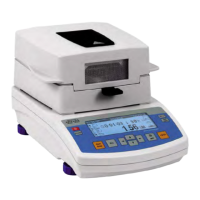13.6. Drying mode analysis
In the first case the drying mode is an asymptote. The humidity content in
a sample reaches a constant and it does not change after long drying time.
Using this drying mode enables easy obtaining of repeatable humidity content in a
tested sample.
The measurement result refers specifically to the constant asymptote value. It easily
corresponds and it is simple to determine appropriate finish mode criterion.
The other type of drying mode in its initial stage is carried out rapidly, and later on it
slows down. Humidity content never reaches a constant value. The drying mode in
this case may form in the following way:
The sample demonstrates thermal decomposition. The decomposing is sample
(product) evaporation, and the sample losses weight. The fat, oil, plastics and other
volatile ingredients may cause slower evaporation process than in case of water.
The ingredients that evaporate hard cause decreasing of sample mass.
The measurement result using this drying mode can be optimistic:
• Decreasing temperature may slow down ingredients’ reaction.
• Selecting an appropriate finish mode criterion may enable detecting an
end of the analysis in the described drying point.
• Selecting a constant drying process often ensures very good results.
• Permanent maintaining initial mass of a sample to be tested
(+10%....+20%).

